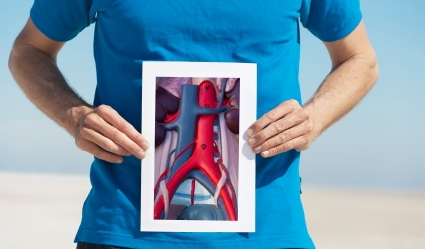Ureteroscopy procedures use a long, thin instrument—a ureteroscope—to allow surgeons to look and work inside the ureters, the tubes that carry urine from the kidneys to the bladder.
The Ureteroscope
A ureteroscope is a type of endoscope, a long, thin tube (either rigid or semi-flexible) with a camera and light source at its tip. Different types of endoscopes have different uses—ureteroscopes are especially long and thin, which allows them to be inserted into the urethra and guided up through the bladder into the ureter.
As a diagnostic tool, the ureteroscope can provide a visual of the upper part of the urinary tract (between the kidneys and the bladder), allowing a surgeon to identify the underlying cause of a presenting condition or symptoms.
The ureteroscope tube can also be used as a channel, allowing surgical tools (such as a wire prong grasper or an optical fiber for laser surgery) to be funneled down to the viewing area for other medical procedures (see below).
Uses of Ureteroscopy
Ureteroscopy can help doctors identify the cause of symptoms in the urinary tract system, such as:
- Blood in the urine (hematuria)
- Frequent urinary tract infections
- Unusual cells in a urine sample (urinalysis)
- Blockage of urine due to narrowing of the ureter
- Unusual growth (cancer, tumor, polyp or otherwise) in the ureter
In addition to providing a look inside the urinary tract system, ureteroscopy can be used to carry out medical procedures, including:
- Kidney stone removal: A small basket at the end of a wire is inserted through a second channel in the scope to remove the stones. If the hard deposits cannot be retrieved this way, a thin laser fiber can used to break them into smaller pieces that can be passed out of the body in urine.
- Biopsy: A tiny scalpel is inserted through the scope to remove a piece of tissue for examination with a microscope (such as to determine if the cells are cancerous).
- Repairing blockages: Tools, such as lasers or other cutting devices, can be guided through the scope to treat or cut away and remove obstructions that block urine flow. This may include ureteropelvic junction obstruction, strictures, or abnormal growths (e.g. tumors or polyps).
The Ureteroscopy Procedure
Ureteroscopy is an outpatient procedure that is done while the patient is lying on his back with knees raised and apart. The opening of the urethra (the tube that carries urine out of the body) is thoroughly cleansed to prevent infection, and a local anesthetic may be applied around the urethral opening to reduce discomfort.
In most cases, the entire procedure—including the preparation and examination—will take between 15 and 30 minutes. More time may be needed for other procedures like a biopsy or removing a kidney stone.
Complications and Risks
The most common complications of ureteroscopy include:
- Mild burning while urinating
- Small amount of blood in the urine
- Injury to the ureter
- Infection of the urinary tract
- Pain in the belly
Severe symptoms are rare, but include:
- Increased blood in the urine, or blood in the urine that lasts longer than 24 hours
- Severe fever, chills or pain.
References
Cystoscopy and ureteroscopy. (2009). National Kidney and Urologic Diseases Information Clearinghouse (NKUDIC). NIH Publication No. 09–4800.
Spector DA. (2007). Urinary stones. Principles of Ambulatory Medicine, 7th ed.


